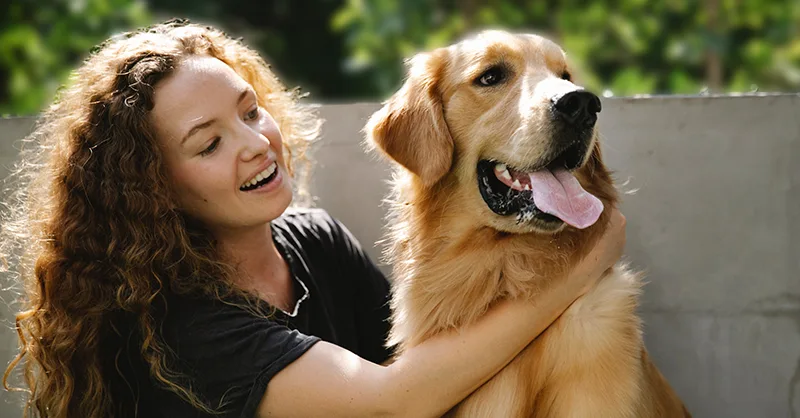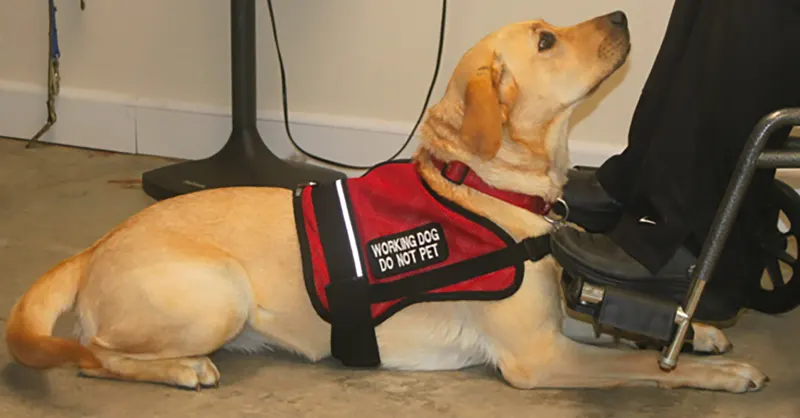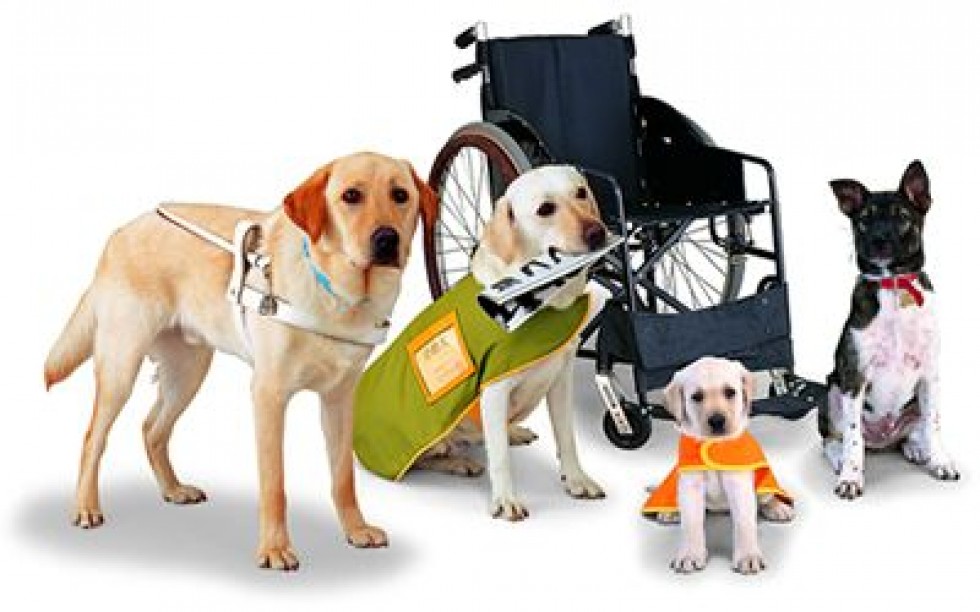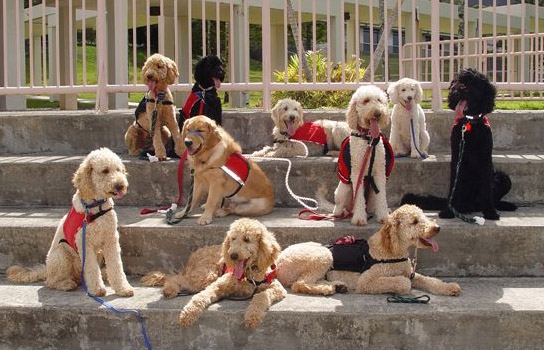Archive for the ‘Service Dog Tips’ Category
The ADA defines a Service Animal as a dog individually trained to perform tasks or do work for the benefit of a person with a disability. A disability can be a physical impairment, but the ADA also includes mental illnesses that substantially limit one or more major life activities, such as depression, severe anxiety, or PTSD.
This article will cover the qualification requirements to be a Service Dog handler, what training and tests can be expected for your Service Dog, and what to expect when in public. After covering the legal rights of Service Dogs, we’ll present options for facilitating interactions with the public, including specialized Service Dog accessories and identification.
What are the Service Dog requirements?Training a dog to become a service animal is available to individuals who have a disability. If you are interested in having a service dog, below are requirements to be aware of:
Eligibility: A person is eligible for a service dog if they have a physical, emotional, or mental health disability
Training: The dog must be trained to take a specific action when needed to assist the person with a disability. The task(s) performed by the dog must be directly related to the person’s disability. The ADA does not require professional training; people with disabilities have a right to train the dog themselves.
Behavior: A service dog must be under its handler’s control at all times.
Verification: If it is not obvious what service the dog provides, the handler must be willing to answer two questions about their service dog. These two questions are: (1) is the dog a service animal required because of a disability? and (2) what work or task has the dog been trained to perform? Staff are not allowed to request any documentation for the dog, require that the dog demonstrate its task, or inquire about the nature of the person’s disability.
Identification: Optionally, it can help service dogs to be clearly identified with accessories like ID cards, vests, tags, and certificates.
How does my dog become a Service Dog?Consider these four simple steps to help you understand how your dog can become a service dog.
Determine if you have an eligible disability Train your Service Dog Pass a Public Access Test Consider Service Dog Certification and RegistrationService Dogs serve an important function for those in our community who need special care. It’s crucial for both Service Dog handlers and the general public to be aware of what Service Dog requirements are.
Step 1: Determine if you have an eligible disabilityUnder the ADA, you must have a qualifying condition to have a Service Dog. The condition can take many forms (physical, mental, etc.). Physical disabilities include conditions like visual impairment, limited mobility, and hearing loss. The physical or mental impairment must substantially limit a major life activity like the ability to work, move about, socialize, or sleep.
Some common conditions that qualify for Psychiatric Service Dogs are anxiety, depression, and PTSD, but this list is not exhaustive. For psychiatric disabilities, a common first step is to be evaluated by a Licensed Mental Healthcare Practitioner (LMHP) who can write a letter confirming your eligibility. These PSD letters typically have the following traits:
written on the licensed healthcare professional’s letterhead dated and signed by the professional contain the professional’s contact information, license number, license date, and state of licensure contain the professional’s opinion on whether you have a mental or emotional disability that can qualify for a psychiatric service dog Step 2: Training your Service DogTo be considered a Service Dog, a dog must be individually trained to perform a job or task relating to your disability. Be aware that there is no official organization that sets training standards in the U.S. You are not required to work with a trainer – the ADA allows handlers to train their dogs on their own.
While there’s no minimum requirement in the US, some private standards suggest approximately 120 hours over six months. Some sources recommend that at least 30 hours (about ¼ of the time) be spent in public to help train the dog for moments of distraction and when surprises come their way. While not required, it can be helpful for Service Dogs to wear relevant accessories so that people in public can adjust their behavior accordingly.
The most important thing for you to teach your Service Dog is tasking or learning the specific skill they will be performing to help assist with your disability. There are countless tasks Service Dogs are called on to perform, including guiding the visually impaired, pulling a wheelchair, sensing a medical alert, tactile stimulation during a panic attack, reminding the handler to take their medication, scouting a room for someone with PTSD, or grounding/blocking in public areas.
Step 3: Pass a public access testIn addition to training your dog to perform tasks that assist with your disability, it is important for a service dog to be able to comport itself appropriately in public by passing a public access test.
Public Access Criteria:
No aggressive behavior towards people and other animals. Refrain from sniffing behaviors unless released to do so. No solicitations for food or affection while on duty. No over-excitement and hyperactivity in public. Able to tolerate novel sights and sounds in various public settings. No unruly behavior or excessive barking. No relieving themselves in public without being given a specific command.Once your dog is properly trained, your next step is to decide how you prefer to identify your service dog.
Step 4: Service Dog Certification and RegistrationIn the United States, service dog certifications and service dog identifications are not legally required. Staff at a public establishment cannot solicit documentation, such as proof that the animal has been certified, trained, or licensed as a Service Dog, as a condition for entry.
Despite the limited verification requirements established by the law, staff at many public establishments will still insist on IDs or other tangible proof of Service Dog status. Service Dog handlers often find it helpful to have documents and accessories that help signal that their dog is trained and at work in order to prevent being met with hostility and confusion.
Electing to carry a custom Service Dog ID card and Service Dog Vest may be helpful tools for you and your service dog to navigate public spaces. You may also choose not to carry the ID card and stand your ground on principle when you encounter people ignorant of service dog rights. Under ADA rules, staff at a venue may only ask two questions if the handler’s disability is not apparent: (1) is the dog a service animal required because of a disability? and (2) what work or task has the dog been trained to perform?
After you verbally confirm that your dog is a trained service dog, reasonable accommodations must legally be made for service dogs. Service Dogs can go anywhere their handlers can go, provided they do not pose a health or safety hazard to others. If a particular service animal behaves in a way that poses a direct threat to the health or safety of others, has a history of such behavior, or is not under the control of the handler, that animal may be excluded. If an animal is excluded for such reasons, staff must still offer their goods or services to the person without the animal present. It’s important to understand these rules so you know what rights you have as the owner of a Service Dog and when third parties are violating your rights.
You’re all caught up on what it takes to have a Service Dog!
Ready to register and ID your dog?
Order Here Unable to train your dog as a service dog?You may be interested in an Emotional Support Animal instead. ESAs do not require specific training, have access to no-pet apartments, and are exempt from breed or weight restrictions. Click here to learn more about ESAs.
In short, ESAs are protected under Federal Housing Regulations (but not the ADA), meaning that you cannot be charged any pet rent, deposits, or fees, nor can you or your ESA be denied housing on the grounds of living with a pet, with very few exceptions.
To qualify for an ESA, you must have a licensed mental health practitioner (including, but not limited to, psychologists, therapists, social workers, GPs/PCPs, etc.) write a letter affirming that you have a qualifying condition (including, but not limited to, depression, anxiety, PTSD, etc.) that is helped by an emotional support animal. Additionally, unlike Service Animals, ESAs do not necessarily have to be dogs; cats, rabbits, and birds are other common choices.
¿Quieres leer este artículo en español?Puede encontrar una versión traducida al español de los requisitos para perros de servicio aquí.
Want to read this article in Spanish?You can find a Spanish translated version of Service Dog Requirements here.
There are major legal differences between emotional support animals and service animals. Knowing the difference will help you in understanding your rights. It will also determine how you go about obtaining the right documentation and identification for your animal.
What is the Purpose of Emotional Support Animals and Service AnimalsBy helping individuals with disabilities function better in society, emotional support animals (ESAs) serve a higher purpose than regular house pets. The sole purpose of an emotional support animal is to provide therapeutic benefits to individuals with mental, emotional or psychological disabilities.
On the other hand, service animals provide direct assistance to people with disabilities. A service animal’s main purpose is to perform functions and tasks that individuals with disabilities cannot perform themselves. Direct assistance includes guiding individuals who are blind, picking up items, or alerting and calming a person experiencing a panic attack/anxiety.
What Kinds of Animals can be Emotional Support Animals?Emotional support animals are not limited to just dogs. All domesticated animals can qualify as an emotional support animal as long as they are not a nuisance and are manageable in or around public areas.
Under titles II and III of the Americans with Disabilities Act (ADA), service animals are limited to dogs and, in some cases, miniature horses. The animal must be able to perform tasks directly related to the owner’s disability. Although service animals are limited to dogs and miniature horses, the ADA does not restrict the type of dog breeds.
Training Requirements for ESA’s and Service DogsEmotional support animals are not required by law to have special training because their role is to provide emotional comfort, companionship, friendship, and affection to their owner or handler. Their presence mitigates stress associated with the owner’s psychological or emotional disability.
However, service animals are required under law to be highly trained to work or perform tasks for people with disabilities. To ensure good public behavior and adequate support, dogs undergo extensive training before they become service animals. While every state has different laws regarding training, it can take roughly 1 to 2 years to train a service dog although there are not age requirements. Although training is required by law, people with disabilities are not required to use a professional service dog training program. They may train their service animal themselves.
Documentation for ESA’s and Service AnimalsEmotional support animals are not covered under the Americans with Disabilities Act (ADA). Owners are required to acquire an ESA letter, provided by a licensed mental health professional before they are granted access to apartments with a no-pets policy. The letter should state how the owner’s disability substantially limits their lifestyle and how an emotional support animal is necessary for treating their mental health.
Service animals, on the other hand, are entitled to accompany their owners in all public areas and facilities. Under ADA, businesses are only allowed to ask (1) if the dog is required due to a disability and (2) what task the dog has been trained to perform. Unlike owners of emotional support animals, service animal owners are not required to show documentation. Some service animal handlers may chose to carry an service dog identification card or have a vest on their service dog to avoid harassment by people who are ignorant to service dog rights.
We hope this helps clarify some misperceptions you may have had on Emotional Support Animals and Service Dogs! Share this article to help your friends or family find the help they may need.
The official definition of a service dog is that it’s an animal trained to do particular tasks for a person with a physical or mental disability. These tasks must be connected to how the person is able to function. The service dog works to compound, support and assist these activities or mitigate the person’s impairment. The ADA only allows dogs and miniature horses to become service animals.
Why train a service dog?Training of a service dog might be facilitated by an expert through a program for service dogs. However, enlisting in professional programs is not a requirement. The individual with the disability can actually train his dog himself or herself.
Apart from making a disabled person’s life easier, it’s important for service dogs to get the proper training so that the animals can have access in public properties. Under the stipulations of the ADA, trained service dogs can be with their owners inside restaurants, hospitals, airplanes, hotels and other establishments. Service animals must be allowed access to wherever their handlers are allowed access.
Service dogs are not exempt from following human rules when visiting establishments with their handler. If a service dog causes a disturbance or creates any damages, a business or airline or any other establishment is allowed to ask the handler to remove their service dog from the establishment.
What are Service Dogs? Service dogs may also be referred to as: Therapy or psychiatric dogs that help those suffering from psychological impairment or other emotional difficulties. These dogs can be found at hospitals or retirement homes Guide dogs or signal dogs that help people with physical and mental disability. A blind person, for instance, will need a service dog for his mobility. A person suffering from neurological disability, such as someone with PTSD, might need a signal dog to warn him or the people around him of triggers before these happen.Service dogs are considered more than pets because of these specific and important tasks they perform for their handlers on a daily basis. Any breed of dog can become a service dog, but the distinction is not acknowledged for other animals, whether they are domestic or wild. This means cats, birds, monkeys, or any other animals are not allowed to be designated as a service animal.
Below is the official definition of service dogs from the Americans With Disabilites Act: “A service animal is defined as a dog that has been individually trained to do work or perform tasks for an individual with a disability. The task(s) performed by the dog must be directly related to the person’s disability.”
Registering Service DogsRegistration of a service dog is not necessary or required by law. Although it is not required, it may be beneficial for a service dog handler to register their dog in order to maintain their privacy. By showing their identification card when questioned about their service dog, the handler can avoid divulging private medical information to complete strangers. Since many people do not understand the rights of service dogs, having an identification card is a personal preference for handlers.






